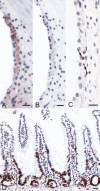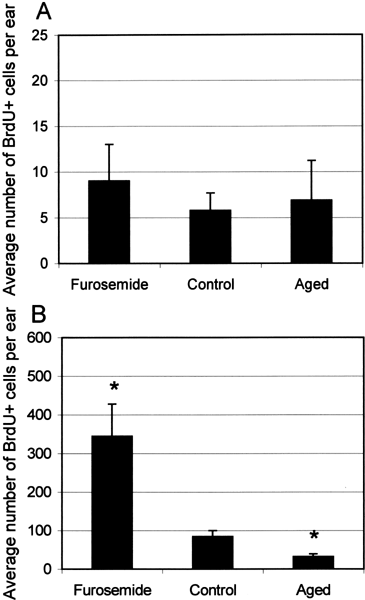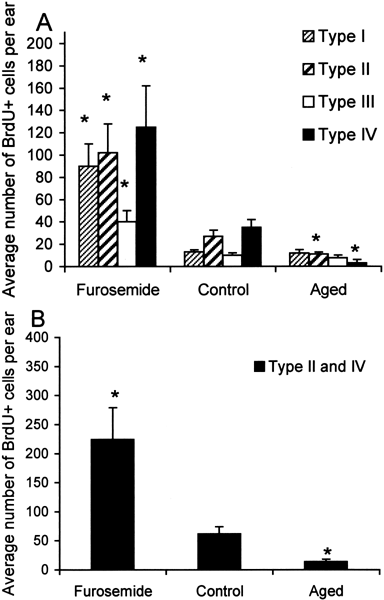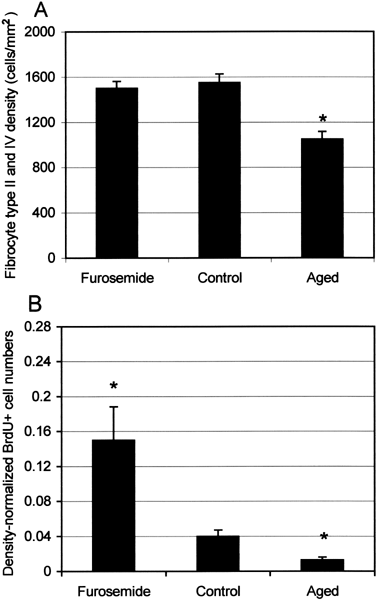Effects of chronic furosemide treatment and age on cell division in the adult gerbil inner ear
- PMID: 12943371
- PMCID: PMC3202712
- DOI: 10.1007/s10162-002-2056-4
Effects of chronic furosemide treatment and age on cell division in the adult gerbil inner ear
Abstract
Atrophy of the stria vascularis and spiral ligament and an associated decrease in the endocochlear potential (EP) are significant factors in age-related hearing loss (presbyacusis). To model this EP decrease, furosemide was delivered into the round-window niche of young adult gerbils by osmotic pump for seven days, chronically reducing the EP by 30-40 mV. Compound action potential (CAP) thresholds were correspondingly reduced by 30-40 dB SPL at high frequencies. Two weeks after withdrawal of furosemide, the treated ears showed an EP recovery of up to 20-30 mV along with a similar recovery of CAP thresholds. The influence of cell division on furosemide-induced and age-related decline of the EP was examined using a mitotic tracer, bromodeoxyuridine (BrdU). Cell proliferation was examined in three groups: young control, furosemide-treated, and aged cochleas. Sections immunostained for BrdU were bleached with H2O2 to eliminate ambiguities with melanin pigment in the inner ear. Cell types positively labeled for BrdU in all three groups included Schwann cells in Rosenthal's canal; glial cells in the osseous spiral lamina; fibrocytes in the limbus, sacculus, and spiral ligament (SL); epithelial cells in Reissner's and round-window membranes; intermediate cells in the stria vascularis; and vascular endothelial cells. Quantitative analysis showed that the mean number of BrdU-positive (BrdU+) intermediate cells in the stria did not differ significantly among the three groups. In contrast, there was a significant increase of BrdU + fibrocytes in the SL of furosemide-treated animals as compared to the young control group. Moreover, there was a significant decrease in labeled fibrocytes in the aged versus the young ears, particularly among the type II and type IV subtypes. The results suggest that the increased fibrocyte turnover in the SL after furosemide treatment may be related to the recovery of EP and CAP thresholds, supporting the hypothesis that fibrocyte proliferation may be essential for maintaining the EP and cochlear function in normal and damaged cochleas. Moreover, the decreased turnover of SL fibrocytes with age may be a contributing factor underlying the lateral wall pathology and consequent EP loss that often accompanies presbyacusis.
Figures









References
-
- Crouch JJ, Sakaguchi N, Lytle C, Schulte BA. Immunohistochemical localization of the Na–K–Cl co-transporter (NKCC1) in the gerbil inner ear. J. Histochem. Cytochem. 1997;45:773–778. - PubMed
-
- Forge A. Observations on the stria vascularis of the guinea pig cochlea and the changes resulting from the administration of the diuretic furosemide. Clin. Otolaryngol. 1976;1:211–219. - PubMed
-
- Franz P, Aharinejad S, Firbas W. Melanocytes in the modiolus of the guinea pig cochlea. Acta Otolaryngol. 1990;109:221–227. - PubMed
-
- Gratacap B, Charachon R, Stoebner P. Results of an ultrastructural study comparing stria vascularis with organ of Corti in guinea pigs treated with kanamycin. Acta Otolaryngol. (Stockh.) 1985;99:339–342. - PubMed
Publication types
MeSH terms
Substances
Grants and funding
LinkOut - more resources
Full Text Sources
Other Literature Sources
Medical
Miscellaneous

